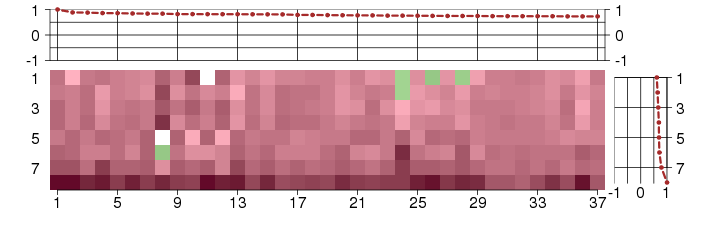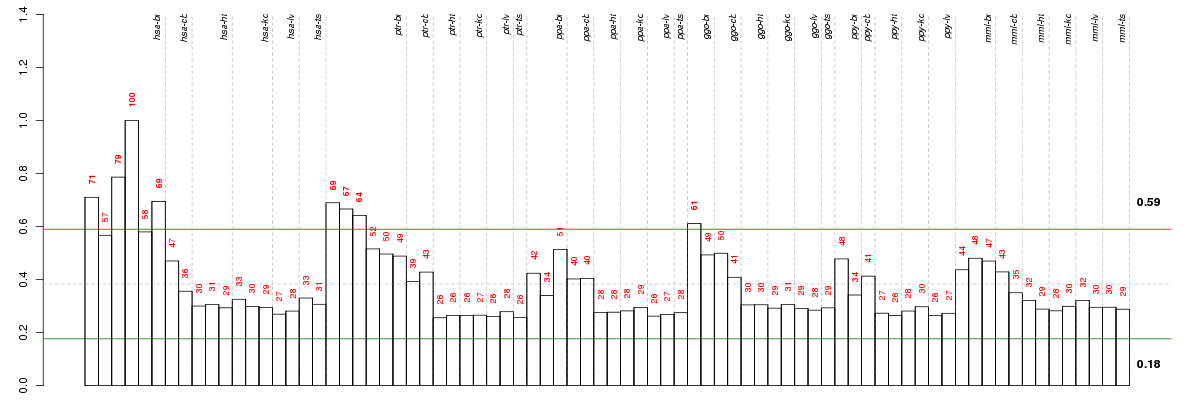



Under-expression is coded with green,
over-expression with red color.

multicellular organismal development
The biological process whose specific outcome is the progression of a multicellular organism over time from an initial condition (e.g. a zygote or a young adult) to a later condition (e.g. a multicellular animal or an aged adult).
nervous system development
The process whose specific outcome is the progression of nervous tissue over time, from its formation to its mature state.
central nervous system development
The process whose specific outcome is the progression of the central nervous system over time, from its formation to the mature structure. The central nervous system is the core nervous system that serves an integrating and coordinating function. In vertebrates it consists of the brain, spinal cord and spinal nerves. In those invertebrates with a central nervous system it typically consists of a brain, cerebral ganglia and a nerve cord.
biological_process
Any process specifically pertinent to the functioning of integrated living units: cells, tissues, organs, and organisms. A process is a collection of molecular events with a defined beginning and end.
cellular process
Any process that is carried out at the cellular level, but not necessarily restricted to a single cell. For example, cell communication occurs among more than one cell, but occurs at the cellular level.
glial cell differentiation
The process whereby a relatively unspecialized cell acquires the specialized features of a glial cell.
neurogenesis
Generation of cells within the nervous system.
cell differentiation
The process whereby relatively unspecialized cells, e.g. embryonic or regenerative cells, acquire specialized structural and/or functional features that characterize the cells, tissues, or organs of the mature organism or some other relatively stable phase of the organism's life history. Differentiation includes the processes involved in commitment of a cell to a specific fate and its subsequent development to the mature state.
multicellular organismal process
Any biological process, occurring at the level of a multicellular organism, pertinent to its function.
developmental process
A biological process whose specific outcome is the progression of an integrated living unit: an anatomical structure (which may be a subcellular structure, cell, tissue, or organ), or organism over time from an initial condition to a later condition.
gliogenesis
The process by which glial cells are generated. This includes the production of glial progenitors and their differentiation into mature glia.
oligodendrocyte differentiation
The process whereby a relatively unspecialized cell acquires the specialized features of an oligodendrocyte. An oligodendrocyte is a type of glial cell involved in myelinating the axons of neurons in the central nervous system.
system development
The process whose specific outcome is the progression of an organismal system over time, from its formation to the mature structure. A system is a regularly interacting or interdependent group of organs or tissues that work together to carry out a given biological process.
anatomical structure development
The biological process whose specific outcome is the progression of an anatomical structure from an initial condition to its mature state. This process begins with the formation of the structure and ends with the mature structure, whatever form that may be including its natural destruction. An anatomical structure is any biological entity that occupies space and is distinguished from its surroundings. Anatomical structures can be macroscopic such as a carpel, or microscopic such as an acrosome.
cellular developmental process
A biological process whose specific outcome is the progression of a cell over time from an initial condition to a later condition.
all
NA
multicellular organismal development
The biological process whose specific outcome is the progression of a multicellular organism over time from an initial condition (e.g. a zygote or a young adult) to a later condition (e.g. a multicellular animal or an aged adult).
cellular developmental process
A biological process whose specific outcome is the progression of a cell over time from an initial condition to a later condition.
system development
The process whose specific outcome is the progression of an organismal system over time, from its formation to the mature structure. A system is a regularly interacting or interdependent group of organs or tissues that work together to carry out a given biological process.
central nervous system development
The process whose specific outcome is the progression of the central nervous system over time, from its formation to the mature structure. The central nervous system is the core nervous system that serves an integrating and coordinating function. In vertebrates it consists of the brain, spinal cord and spinal nerves. In those invertebrates with a central nervous system it typically consists of a brain, cerebral ganglia and a nerve cord.
neurogenesis
Generation of cells within the nervous system.
oligodendrocyte differentiation
The process whereby a relatively unspecialized cell acquires the specialized features of an oligodendrocyte. An oligodendrocyte is a type of glial cell involved in myelinating the axons of neurons in the central nervous system.
glial cell differentiation
The process whereby a relatively unspecialized cell acquires the specialized features of a glial cell.

membrane
Double layer of lipid molecules that encloses all cells, and, in eukaryotes, many organelles; may be a single or double lipid bilayer; also includes associated proteins.
integral to membrane
Penetrating at least one phospholipid bilayer of a membrane. May also refer to the state of being buried in the bilayer with no exposure outside the bilayer. When used to describe a protein, indicates that all or part of the peptide sequence is embedded in the membrane.
cellular_component
The part of a cell or its extracellular environment in which a gene product is located. A gene product may be located in one or more parts of a cell and its location may be as specific as a particular macromolecular complex, that is, a stable, persistent association of macromolecules that function together.
cell
The basic structural and functional unit of all organisms. Includes the plasma membrane and any external encapsulating structures such as the cell wall and cell envelope.
intrinsic to membrane
Located in a membrane such that some covalently attached portion of the gene product, for example part of a peptide sequence or some other covalently attached moiety such as a GPI anchor, spans or is embedded in one or both leaflets of the membrane.
membrane part
Any constituent part of a membrane, a double layer of lipid molecules that encloses all cells, and, in eukaryotes, many organelles; may be a single or double lipid bilayer; also includes associated proteins.
cell part
Any constituent part of a cell, the basic structural and functional unit of all organisms.
all
NA
cell part
Any constituent part of a cell, the basic structural and functional unit of all organisms.
membrane part
Any constituent part of a membrane, a double layer of lipid molecules that encloses all cells, and, in eukaryotes, many organelles; may be a single or double lipid bilayer; also includes associated proteins.

ADAMTS14ADAM metallopeptidase with thrombospondin type 1 motif, 14 (ENSG00000138316), score: 0.82 ATP10BATPase, class V, type 10B (ENSG00000118322), score: 0.76 C11orf9chromosome 11 open reading frame 9 (ENSG00000124920), score: 0.78 C1orf198chromosome 1 open reading frame 198 (ENSG00000119280), score: 0.74 C22orf9chromosome 22 open reading frame 9 (ENSG00000100364), score: 0.73 CD22CD22 molecule (ENSG00000012124), score: 0.89 CERCAMcerebral endothelial cell adhesion molecule (ENSG00000167123), score: 0.75 CHADLchondroadherin-like (ENSG00000100399), score: 0.77 CLCA4chloride channel accessory 4 (ENSG00000016602), score: 0.82 CLDND1claudin domain containing 1 (ENSG00000080822), score: 0.75 CMTM5CKLF-like MARVEL transmembrane domain containing 5 (ENSG00000166091), score: 0.74 CNP2',3'-cyclic nucleotide 3' phosphodiesterase (ENSG00000173786), score: 0.86 DAAM2dishevelled associated activator of morphogenesis 2 (ENSG00000146122), score: 0.79 ELOVL1elongation of very long chain fatty acids (FEN1/Elo2, SUR4/Elo3, yeast)-like 1 (ENSG00000066322), score: 0.76 EML2echinoderm microtubule associated protein like 2 (ENSG00000125746), score: 0.73 EVI2Aecotropic viral integration site 2A (ENSG00000126860), score: 0.77 FA2Hfatty acid 2-hydroxylase (ENSG00000103089), score: 0.81 FAM124Afamily with sequence similarity 124A (ENSG00000150510), score: 0.81 FFAR1free fatty acid receptor 1 (ENSG00000126266), score: 0.84 GALNT6UDP-N-acetyl-alpha-D-galactosamine:polypeptide N-acetylgalactosaminyltransferase 6 (GalNAc-T6) (ENSG00000139629), score: 0.86 GLDNgliomedin (ENSG00000186417), score: 0.81 KCNH8potassium voltage-gated channel, subfamily H (eag-related), member 8 (ENSG00000183960), score: 0.88 KREMEN2kringle containing transmembrane protein 2 (ENSG00000131650), score: 0.76 LGR5leucine-rich repeat-containing G protein-coupled receptor 5 (ENSG00000139292), score: 0.75 MAGmyelin associated glycoprotein (ENSG00000105695), score: 0.74 NIPAL4NIPA-like domain containing 4 (ENSG00000172548), score: 1 NKX2-2NK2 homeobox 2 (ENSG00000125820), score: 0.74 NPC1Niemann-Pick disease, type C1 (ENSG00000141458), score: 0.82 PIP4K2Aphosphatidylinositol-5-phosphate 4-kinase, type II, alpha (ENSG00000150867), score: 0.77 PRR18proline rich 18 (ENSG00000176381), score: 0.84 PTK2PTK2 protein tyrosine kinase 2 (ENSG00000169398), score: 0.75 PTPRHprotein tyrosine phosphatase, receptor type, H (ENSG00000080031), score: 0.73 SIRT2sirtuin 2 (ENSG00000068903), score: 0.84 SLC5A11solute carrier family 5 (sodium/glucose cotransporter), member 11 (ENSG00000158865), score: 0.79 SOX8SRY (sex determining region Y)-box 8 (ENSG00000005513), score: 0.74 TJAP1tight junction associated protein 1 (peripheral) (ENSG00000137221), score: 0.82 TMEM144transmembrane protein 144 (ENSG00000164124), score: 0.82
| Id | species | tissue | sex | individual |
|---|---|---|---|---|
| ggo_br_m_ca1 | ggo | br | m | _ |
| ptr_br_m5_ca1 | ptr | br | m | 5 |
| ptr_br_m2_ca1 | ptr | br | m | 2 |
| ptr_br_m3_ca1 | ptr | br | m | 3 |
| hsa_br_f_ca1 | hsa | br | f | _ |
| hsa_br_m7_ca1 | hsa | br | m | 7 |
| hsa_br_m3_ca1 | hsa | br | m | 3 |
| hsa_br_m6_ca1 | hsa | br | m | 6 |
